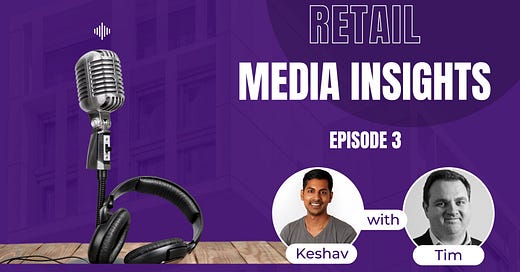My guest for Episode 3 is Tim Abraham, who is the Senior Director of Data Partnerships at The Trade Desk (TTD).
NEW FEATURE: The contents of this episode are available both as a podcast and in a condensed written Q&A format below for those who like to read.
In this episode, we discuss:
(01:53) Tim's journey from LiveRamp to TTD
(03:53) Reasons for growing importance of retail data for media activation
(08:00) Ad optimisation options prior to retail data partnerships?
(08:59) Differences in data partnerships with TTD versus with Data Clean Rooms
(13:00) Technical options for sharing data with TTD
(18:06) Controls placed on use of retail data for media activation by brands
(19:31) Go-to-market options for retail media companies
(23:40) Fragmentation of retail media
(25:52) Targeting capabilities for advertisers, and their associated impact
(28:39) Technical details of how TTD finds relevant audience in the open web
(30:22) Tim's surprising learnings over the last two years
_______________________________
Q: You moved from doing data partnerships at LiveRamp to now leading data partnerships at The Trade Desk. What led you to that move?
A: Tim Abraham
Yeah. I should preface the answer to that question, which is I've only ever really worked in ad tech and digital media. Since I finished my master's an undisclosed number of years ago, I haven't really done anything else. I haven't strayed far is the first thing.
Why the move? So I should actually first say, LiveRamp was a fantastic place to work. It's a great business and I have a lot of respect for what they're doing. I was working on launching their Safe Haven product, which has now become a bit of a flagship product for them.
So I was super happy there. I was just moving to get a bit closer to the data activation. LiveRamp is really around data preparation, but they are not running campaigns. So that was mainly the reason.
Q: The importance of retail data for media activation increased significantly with development of cookie deprecation. Why didn’t it happen before, as retail data is much richer for media targeting and measurement than data provided by cookies?
A: Tim Abraham
Yeah. So it's a good question. And cookie deprecation, maybe I'd rephrase that as kind of changes in the identity ecosystem, have definitely been a catalyst. Just backing up - when we talk about the retail data that Trade Desk is surfacing and making available, it is used both for targeting and reducing media wastage, but also for optimisation and measurement. We often overlook the latter usage.
So instead of optimising towards a click through rate, which still happens, I can optimise actually towards the fact that somebody has bought my product in a store.
With that in mind, there are a few other reasons for the rising importance of retail data in media activation. I think retailers have realized that the data they hold is hugely valuable, and very differentiated to what walled gardens have access to. Retail data around what people are buying is as valuable as what people search and their social behaviour.
Some media channels, like Connected TV, have never had cookies. [They operate through email addresses.] The nice thing about retail data is it's nearly always connected back to an email address. That means that their data can be used across multiple channels.
We hear from brands that they are now making decisions on whether passing through an extra 10 percent of cost to a consumer or saving money in the media budget. And clearly the preference for most brands and most advertisers is to be more efficient with media than passing through cost to consumers and making front page of the newspaper. And retail data really helps with reducing wastage.
Q: How did advertisers optimise for sales prior to retail data partnerships?
A: Tim Abraham
Some CPGs and some advertisers sell some products through their own websites that they could then track transactions for, but the vast majority of sales are happening in retailers. A CPG does not have direct access to that data. So historically they would have been optimising towards maybe brand lift. It could be based on a media mix model which is where you try through time series to see how much sales increases by when you spend a bit more this week in a particular channel. But it was all disconnected from the tangible story of “This pseudonymous user saw an ad, and then a week later they went in store and bought something.”
Q: For retail media companies, what are the differences in establishing data partnerships with TTD versus data clean rooms for a retail media solution?
A: Tim Abraham
A Demand Side Platform, such as TradeDesk, is the activation layer where optimisation and targeting happens. In the case of TradeDesk, we also have a bunch of AI and analytics and insights and audience curation that happens as well. Not all DSPs have that richness, so I guess the single truth of a DSP is that it's where campaigns get delivered. It's where you put in a campaign, type in a budget, and set it live. It's also for that reason that it is in the DSP where data control is most important i.e., it's in the DSP where you need to make sure that data is being used by the right people for the right purpose. The Trade Desk also does a lot of stuff actually that bleeds into kind of DMP and analytics. But the core piece is optimisation and targeting.
Now a clean rooms are where data collaboration happens. So if you have two companies who want to work together with data in some way, but are restricted from sending data directly to one another, they can both put their data into this clean room environment. And then there are controls around how that data can be merged and combined. So often that's where analytics would happen. The use case is really around analytics and collaboration. It's not about activation.
Audience building happens in both places. I think the answer to the question of when you should use what is really very much on a case by case basis. I don't think I have a very clean answer for you on exactly when to use which.
Q: What technical work needs to be done by retail media companies to kick-off their partnership with The Trade Desk?
A: Tim Abraham
There is broadly speaking two ways that we can work with retailers. Option one is called code on page. As the name suggests, we put a tag onto the e commerce part of a retailer's webpage, and this tag collects data. Then in the trade desk platform, we build the audiences. And then in TTD platform, the retailer has control over which advertiser can access that data. The tag can collect information such as customer’s behaviour on the website, add to basket, purchase etc. Retailers can also send metadata with the tag such as whether the customer who bought the product is new to brand or new to category, stock levels of the product etc. Of course, this option can only be used for digital retail - you cannot put tag in a store.
Just as a side note, when we talk about people targeting data, that doesn't mean that the advertiser is being given the data to download it or put it somewhere in their own database. In the case of TradeDesk, it means you're ticking a box to turn on targeting, but you don't get the data yourself. So that's code on page and that's a really good solution where a retailer hasn't got or hasn't invested in their own DMP or clean room or audience building technology.
Option two is where retailer builds audiences, prepares data in their own system, and then sends that data to trade desk via API. And then the audiences become available in the platform. From an advertiser perspective, those two things feel the same. So they don't need to worry about how the data is being pulled in. This option is used for sending data collected in store, and allows retailers to send historical data on customers as well. Most retailers we work with who use this option send data refreshes on a daily basis via APIs.
Q: What are the common controls placed by retail media companies on use of their retail data for media activation by brands?
A: Tim Abraham
Retailers would not like brands to use their audience data in a media campaign which points the customer to another retailer. We have reporting in the platform that can help manage that.
The other common control, which is harder to enforce, is co-branded creative where the retailer may require the brand to use the retailer’s logo in the creative along with the brand’s own logo. Or sometimes a brand may want to run co-branded creative and a retailer may not allow. These are handled more by business rules but it is something we're looking at actually enforcing.
Separately, retailers could require brands to share their creatives prior to the campaign going live as a partnership requirement for using the retailer’s audience data.
Q: What are the go-to-market options for retail media companies for offsite media through TTD?
A: Tim Abraham
I'll try and group it into two options. The first option is managed service where the retailer runs campaigns on behalf of the advertiser. So the retailer would be using the Trade Desk platform and they run campaigns on behalf of advertisers through their own account seat at Trade Desk. So Tesco in the UK do this at the moment with Trade Desk.
The second option is self-serve where the campaigns are run in the advertiser's own account seat with Trade Desk. Advertiser would login to their Trade Desk account, go into the audience DMP page and they tick a box that says “I want to target the Tesco audience” and then the campaign is run actually in the advertiser's account seat.
There are a couple of advantages of managed service. First, not all brands have access to their own Trade Desk account seat, which is required to run the campaigns. Second, in the managed service model, because the data is always sitting in the retailer's account seat, there's often a richer or deeper data view available at least initially. With self serve, there is a perception that the advertiser is accessing the data in their own account and hence sometimes retailers don't want to make quite as much available. That definitely will change as people become comfortable.
The big advantage of self serve from a retailer perspective is that it provides retailers with incremental, low overhead, revenue stream. Once the retailer has done the integration work, Trade Desk then handles all of the invoicing and contracting and billing. We provide the route to market to an advertiser. There's not a lot of work that the retailer needs to do. The advertisers working with The Trade Desk don’t need to go and have a new contract with the retailer. The retailer just turns on their audience on our platform, and then it's discoverable for advertisers, and the retailer just earns a data fee.
But The Trade Desk will be neutral in how we present the retailer data to market. We will not favour one retailer’s data over another for commercial reasons. Our big differentiators versus other walled gardens is that we don't own our own data and we don't own our media. We provide a marketplace where we are neutral.
Q: What is your view on the fragmented retail media landscape? And how can The Trade Desk help solve it?
A: Tim Abraham
We were looking at some research from IAB, and the UK retail media market is currently around GBP 180 million. Today most of that is spent on these retail media network solutions where retailers are managing the campaign so that could be on site or offsite. Self serve part is a growing.
But as an advertiser, if I wanted to work with five different retailers, I would need five different IOs, I would get back five different reports that would have five different sets of metrics. And even if the metrics were the same, they might have different methodologies or attribution rules. And I certainly can't do something like manage frequency across those five different things. I can optimise in the sense of moving budget around. But not any more granular than that. It's so difficult to try and do anything consistently across retailers.
The big advantage of working through a DSP for the self serve piece, is that for those five retailers, the experience is the same. As an advertiser, I log in, and I can tick the box for audiences of those five different retailers. The report I get back looks the same. The attribution window is actually defined by the advertiser, so they can decide. Advertiser can frequency cap and optimise in real time between different retailer audiences.
Q: From an advertiser perspective, what are the different targeting options available in a post-cookie deprecation world, other than retailer audiences? And what are the initial results for advertisers who are starting to use retail audiences?
A: Tim Abraham
Contextual audience is where we've seen a huge amount of growth, especially in relation too Connected TV. We've actually seen uh more contextual providers emerge actually to address that kind of market opportunity.
In terms of early results for advertisers using retail audiences, we are about to publish a case study where the advertiser doubled their RoAS over four weeks by using retail data. If you take a step back, the result is intuitive. If I'm selling pet food and I can really exclude people that don't have a pet, it's not a huge surprise that we see those kind of performance increases. We're also working on product improvements to do more incremental work, so we can actually look at real lift.
But we shouldn't try and compare like a return on ad spend or ROAS of a CTV top of funnel campaign to a sponsored search ad on retailer website. We shouldn't expect the same performance for those things. And that's kind of a piece of education that needs to happen.
Q: How does The Trade Desk find the retailer audiences in the open web?
A: Tim Abraham
This comes back actually to the identity piece. We at TradeDesk have the ability to match IDs to one another. So if we received a cookie ID, we are able to match that to say a mobile device ID. Then the way it works technically is [when a customer goes onto a website], the publisher puts it [ad opportunity ] into the bid stream and says, “who wants to buy this ad slot and put an ad in it, and the mobile ID is one, two, three, four”.
And Trade Desk can then match that back to the audience. The future proof piece of this is identity solutions such as EUID, which is Trade Desk email based identity. And that allows publishers and content creators to effectively surface their inventory with an ID which can be connected to an email address. It's all privacy safe. No one can actually see any of those email addresses. But it's underpinned by that identifier. And that then removes the reliance upon the third party cookie.
So that's why this retail data being linked to an email is so important because it means in a future where we have an opt in internet and publishers are using email based IDs, we can tie everything together.
Q: What has surprised you about the offsite media or retail data partnerships space over the last two years?
A: Tim Abraham
I think there's more fragmentation within the agencies and brands than I had realised. I it definitely seems like there are teams that just do the e-commerce piece and teams that are just doing the branding piece. When we're talking about retail data, it's easy for that to be considered an e-commerce solution, but actually as we've talked about it's really an omni channel full funnel opportunity.
And the other thing is I think there's opportunity for CPGs to experiment and test more with this kind of data. Retailers generally are starting with a small or a limited version of what they could be doing because they want to judge market demand. If brands and CPGs don't test those small green shoots, then that will send a signal to retailers that there isn't an opportunity. I would love it if we, at Trade Desk, can take brands on a journey to test and explore what's available now and then jointly grow the ecosystem because I genuinely believe that getting to a place a year from now where the biggest retailers globally have activated their data, and made it available in a safe and secure way, will be really disruptive to the ecosystem. And we'll save a lot of people a lot of money on media wastage. And we'll help a lot of retailers build a revenue stream. So it really is a a win win win to use that terminology.












Share this post